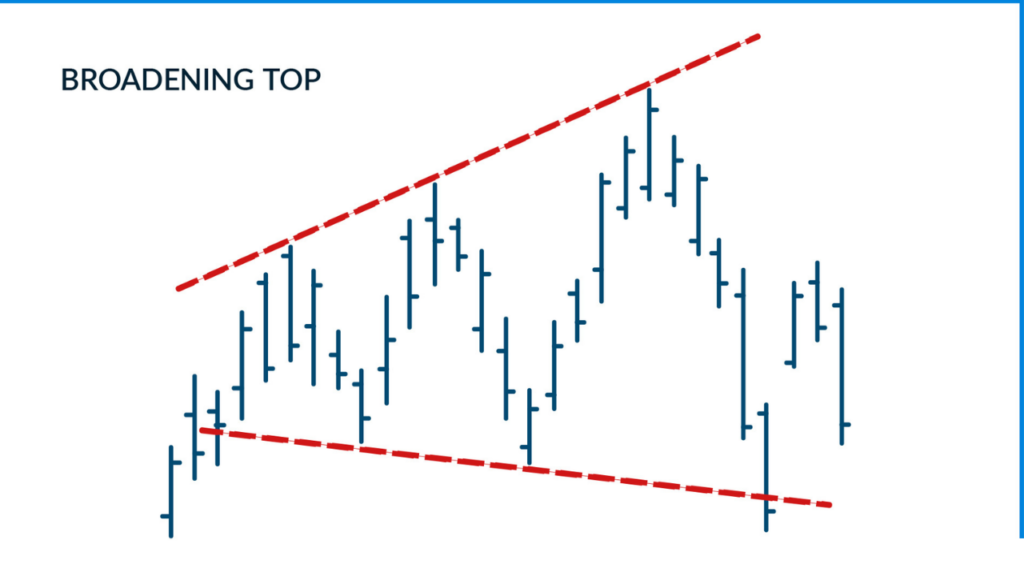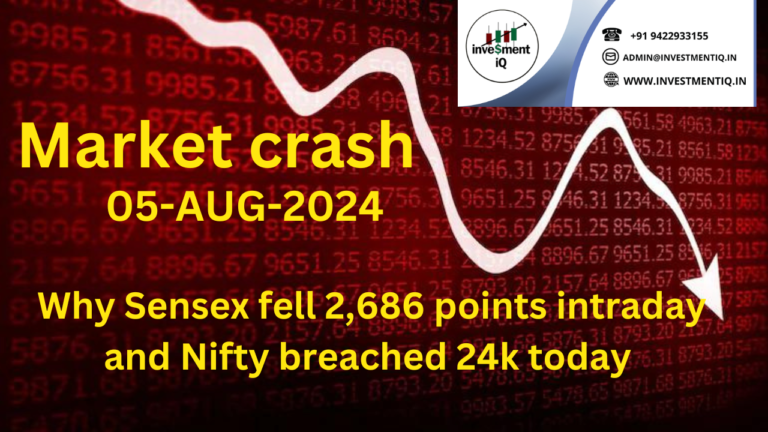Broadening Top or Megaphone Top
What Is a Broadening Top?
A chart pattern with a series of higher peaks and lower dips is known as a spreading top. The pattern would seem like a megaphone or a reverse triangle if you were to draw a trendline across the top and bottom of the price movement.
What Does the Broadening Top Indicate?
Whether it’s a broadening top or a broadening bottom, the most trustworthy sign that any broadening formation is telling us is that bullish and bearish investors are at odds with one another. While negative investors sell (or sell short) the stock, causing it to decline, bullish investors are bidding it higher. You consequently witness a string of successive lower lows (LLs) and higher highs (HHs).
Are Broadening Tops Bearish or Bullish?
While many long-term investors consider broadening tops to be bearish, as volatility and uncertainty tend to be bearish, the historical performance of this pattern makes it much less discernible:
- Its historical performance as a bearish or bullish pattern is poor, as it tends to pull back into the pattern range over 60% of the time (meaning, if you trade the breakout, it will likely pull back in the opposite direction of your trade).
- For a “topping” formation, its historical statistics tell us that it often tends to rise more than it falls, making it more of a continuation pattern than a reversal pattern.
- Still, the pattern is tradable, but given its volatile characteristics, you might expect it to exhibit wide fluctuations (post-breakout) even if it eventually reaches your profit target.
How Do You Identify Broadening Tops? There are a couple of key characteristics to pay attention to when identifying a Broadening Top:
- Number of Touches. There should be at least five touches in total. Three of these can be peaks or valleys that touch the associated trend line. Two or more touches should be of the other trendline. Bear in mind that a “touch” is different from an “approach” that comes close to the trend line but doesn’t touch. Ideally, the second touch should make contact with the trend line.
- Filled Spaces. Prices should cross the pattern from one side to the other, filling the area with price movement. In short, there shouldn’t be wide “white spaces” in the pattern showing a lack of price activity.
- Breakout Direction. A breakout can occur in any direction and happens when the price pierces a trendline or moves above/below the height of the formation.

Illustration of broadening top or megaphone top pattern.
How Do You Trade a Broadening Top?
One of the most common approaches to trading a Broadening Top would be to buy an upward breakout or sell a downward breakout.
- Compute the height of the pattern. Calculate the difference between the highest peak and the lowest valley. This gives you the “height” of the pattern.
- If the breakout is to the upside. Add the pattern’s height to the top of the formation to get your potential price target. You can take profits when price reaches 100% of the pattern’s height or close to it.
- If the breakout is to the downside. Subtract the height of the pattern from the bottom of the pattern to get your potential price target. You can take profits when price reaches 100% of the pattern’s height.
- Place a stop loss at the opposite end of the pattern. In short, place it at the opposite swing high or swing low, depending on whether you’re going long or short.
- Beware pullbacks. Once you open your position (long or short), prices tend to pull back into the pattern range over 60% of the time, meaning it will likely go beyond your entry point and in the opposite direction.
Warning. Swing traders have the option to go long or short inside the five-touch sequence, depending on the opposite direction of the formation. Although this is a tradeable opportunity, act with caution as it is a high-risk technique. Which Other Signs Could Assist Me in Trading a Broadening Top? Any sign that can assist you in determining when a market is overbought or oversold is the simple answer. Bollinger Bands, the Stochastic Oscillator, the Relative Strength Index, and others are examples of this.
Additionally, keep in mind key regions of support and resistance, which may be anticipated levels like those that Fibonacci retracements might identify or critical historical levels. Additionally, you should keep an eye on a number of volume indicators that can help you understand the strength and momentum of a breakout (like the Rate of Change) or buying and selling pressure (like the Chaikin Money Flow).
IMPORTANT.Disagreements between market participants frequently lead to broadening formations, such as broadening tops and bottoms. These disputes are typically rooted in broader views of economic (and even political) danger. Even though you can trade them technically, it could be beneficial for you to completely understand the political and economic factors influencing the market as a whole.
The Bottom Line
A distinctive chart pattern known as a “Broadening Top,” which resembles a megaphone or reverse triangle, indicates high volatility and conflict between bullish and bearish investors. Its volatility and ambiguity make it unclear, despite the fact that it is frequently viewed as bearish.
It’s advisable to approach this pattern cautiously and with a clear awareness of your risk tolerance because of its propensity for pullbacks. Furthermore, while a number of technical indicators can be useful when trading Broadening Tops, knowing the larger political or economic environents that are affecting the pattern can provide priceless insights.To put it briefly, the Broadening Top is a pattern that requires both technical knowledge and an awareness of the broader market story, even though it offers a trading opportunity.




